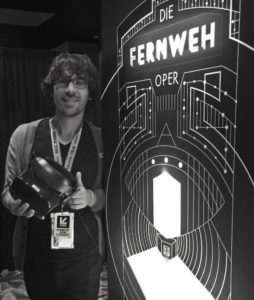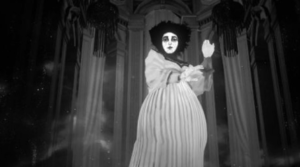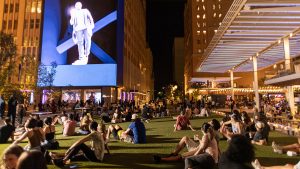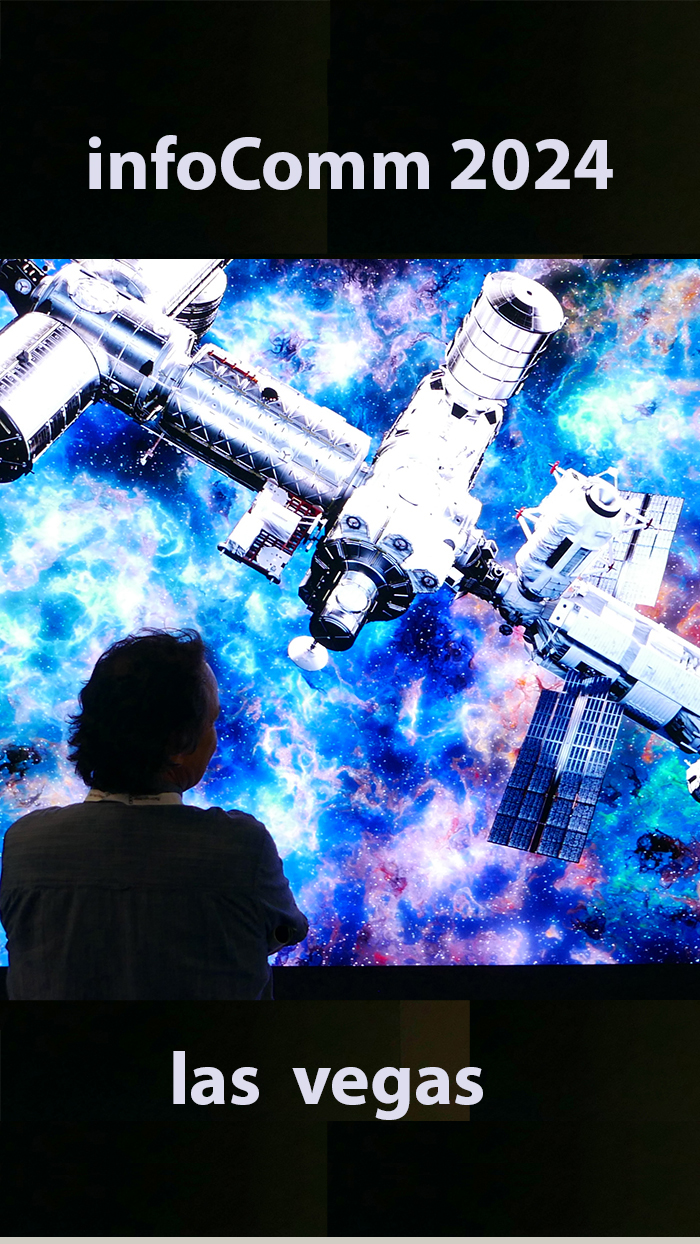
By David Keene
March 21, 2019
At the 2019 SXSW Film Festival that wrapped March 16th in Austin, it wasn’t a Hollywood-produced premiere, or indie feature, that got me thinking about trends in film imaging and the future of the cinema experience. There were plenty of premieres and great features from all quarters at SXSW – as you’d expect from a major film festival. Oddly, it was an intimate scale VR production that both drew me in, and framed two ironies in the industry important to the future of film and video. The production was the SXSW 2019 world premier of the subtle and haunting Die Fernweh Oper – the 4th addition to “The Shoebox Diorama” from Daniel Ernst. The ironies – if you can call technical conundrums ironies – are around the nature of imaging in a changing movie world, and what the evolution of audio in entertainment teaches us about our changing video landscape.

Daniel Ernst at SXSW Film 2019, giving visitors to the VR Cinema showcase an introduction to his entry Die Fernweh Oper.
It’s axiomatic, isn’t it, that in today’s “film” landscape the viewing platform is whatever you want it to be? I often cover the finer technical points of the cinema experience – the big screen, high-resolution theater experience that still holds the promise of pristine images and better-than-35mm film resolution, with ever increasing resolution serving the vision “as the filmmaker intended.” But that effort is going against the grain (excuse the pun) of some strong trends. I’m not sure when the industry began tilting from an adherence to ever-increasing standards of image quality to the new mantra of “get the content to the people” in any format, with mass distribution dictating, seemingly, the game. Form follows function – in any art form?
Until recently, insiders in the movie industry assumed that ever-increasing levels of image quality in the movie experience would always be expected, even demanded, by producers, directors, critics, and fans, just as record industry insiders assumed for decades that consumers would flock to higher resolution audio formats– vinyl to HiFi, to CD, to SuperCD, and beyond. But the audio and music world changed, of course, when MP3 drove high resolution over the edge of a very high cliff. From Napster, to Spotify, it’s been an inexorable march toward power to mass distribution platforms and away from content creators.
But cinema is still steeped, isn’t it, in the tradition and technologies of movie theater exhibition? Yes, and no. Movie theater exhibition is still important (for Hollywood studios more so overseas than in the U.S.). And it’s still addressed by DCI standards – however DCI is becalmed in Hollywood today. Is the biggest challenge to the movie industry coming from the same place that spawned the radical disruption of the recorded music industry – from a reversal of course of what we all thought was the inexorable evolution defined by content producers and consumers always wanting better resolution, to a compromise of standards in favor of broader distribution of content?
While technology and movie business insiders discuss DCI standards, and watch private demos of new-generation projectors or direct view HDR LED screens, a new movie world is churning away beneath them. Step out of the ivory tower of DCI, and SMPTE, and put those brilliant engineers at Barco, Christie Digital, Samsung, and Sony, on hold, and go to a major film festival in this country. Entire generations of new filmmakers are now producing for OTT, or streaming distribution of some kind. Do commercial movie theater experience have a future? Or will they go the way of HiFi audio as the Apples and Googles and NetFlix’s of the world vie for market share to distribute compressed, cloud-bound content. Is simplifying content, technically – for resolution, color space, contrast, or any way you define image quality – now the way of the world and the inevitable conclusion of the cinematic revolution launched by the Lumière brothers more than a century ago?
Even raising that question probably sounds laughably alarmist to any young filmmaker, certainly to a film festival organizer, and to most movie fans. Nostalgia for old media. Old art forms, and platforms. The democratization of an art form (movie making) is held up by most creative people as a breakthrough. Being able to view content anywhere, anytime, is seen as practically an inalienable human right, not to mention a property right for many– regardless of whose property the content originally was or whether or not the original content producer is compensated. (More on that latter note, in a separate article – as Article 13, not even on the radar of filmmakers yet, gets attention. Article 13 did get a full panel session at SXSW Film last week – kudos to SXSW for bringing this issue to the lineup.)
Let me say for the record: we are in, today, another Golden age, for content. However vexing all the disruptions to the creation-production-distribution ecosystems are, there has never been a better time, if great movie content is what you what. It’s everywhere – and festivals like SXSW are at the forefront of showing us new work, new platforms, new directions.
But what does this have to do with that humble VR production that moved me so much at SXSW Film 2019? These issues surrounding the future of the movies are exceedingly vexing. Let’s turn to that one modest piece. It’s through the particular that you arrive at the general, in art, and yes even in VR.
Since you can’t easily see the work that I did, in VR, or in any format, after reading this, let’s frame it up like this:
The two ironies, or conundrums, I alluded to in the opening of this article, are about the particular nature of VR.
First: as “film” becomes VOD, TV, or any screen in your pocket, it’s no longer important what screen you see it on, right? Ah, but the one place this does not hold true is VR.
Second: VR – is it the MP3 of the video world? VR is defined by a technical paradox: of gaining, and losing, a heightened experience. With VR (as well as most AR) as done by most platforms, you gain immersion but you lose image resolution. So while it’s going up on the immersion scale, it’s going down on the “image quality” and resolution scale. Sound familiar? Surround sound (more immersive), and multi-platform distribution, together with MP3 (compressed, lesser resolution audio), did this in the music world: today, no one questions the poor quality (relative to the technologies that preceded it) of MP3 audio. It’s accepted, and established. Because the better immersion and better distribution parts of the equation rule the day.
With VR today, it’s all about headsets. The video resolution of headsets is generally very poor. Pixels the size of golf balls, it seems, as you don the headset. And having each “audience member” needing a separate headset to view VR is a huge hurdle to overcome to get VR past the novelty stage and into more widespread use. VR is far from accepted. There is no real distribution at all– in fact it defies any kind of distribution. It’s a technical conundrum. Will it help save technically sophisticated cinema? Or further its demise?
With these things rumbling around my head as I wandered around the VR Cinema showcase at SXSW Film 2019 in Austin, and the most intriguing work on display was Daniel Ernst’s Die Fernweh Oper, par of “The Shoebox Diorama”. In Die Fernweh Oper you visit a “perpetual opera” performed, in a virtual opera house, by a diva in the form of a 50 ft tall singer named Asteria, hovering literally in starry outer space, who sings to you and about “your foolish love for her,” according to Ernst. Part of the conceit is that just as with the stars you see at night (and hovering in the opera house here), she has already died light years ago and what you see of her in real time is already ages past.
Die Fernweh Oper consists of three scenes. Scene one allows you to listen to Asteria sing for you. In scene two you visit Asteria’s abandoned dressing room in which small porcelain statues will sings a chorale for you. In scene three you visit the custodian whose job it is to replace the stars who have died, among which is Asteria.

In Die Fernweh Oper you visit a “perpetual opera” performed, in a virtual opera house, by a diva in the form of a 50 ft tall singer named Asteria, hovering simultaneously in starry outer space and on stage, who sings to you and about “your foolish love for her.”
If that sounds hopelessly melodramatic, you’re probably not an opera fan to begin with. The work is a haunting, elegiac journey, a kind of super slow motion stellar drifting among nebulae – but all, in the 3D VR rendering, in the confines of an opera house, with Asteria singing indeed, directly you the viewer as stars and even a huge planet drift in and out of the space. You’re suspended in a kind of milky, starry, floor-less mezzanine where the empty chairs around you eventually disappear and turn to more stars as the dreamy libretto weaves like smoke through it all.
The soundscapes of Die Fernweh Oper were recorded by sound artist Armeno Alberts, with the help of his collection of original fifties and sixties synths. Die Fernweh Oper features an original soundtrack with a libretto by the Belgian poet Maud Vanhauwaert, put to music by Misha Velthuis (The Netherlands) & Naren Chandavarkar (India) and with a vocal performance by Swiss opera singer Annina Gieré.
The most arresting quality of the work, visually, is the apparent high resolution of the images. High res VR? Isn’t that an oxymoron? The use of black & white, gives you better resolution – or the illusion of better resolution. Have you ever wondered why the old black and white films of the 1930’s and 40’s seem higher res to your eye than color films of the same era? Filmmakers have known the trick for decades.
I asked Ernst if he chose to do Die Fernweh Oper in black and white in order to get more apparent resolution.
“Yes, “ he said, “I chose black and white to make it look like an abstraction. I tried it in color, but that did not work. But it’s more about how you approach texturing. If you use clear shapes, colors, you don’t see the pixels as much. Think of the painter Edward Hopper, that uses color fields – that looks detailed perhaps at first glace, but it’s not, there is really less detail. You can do the same thing in VR – make sure there’s not a lot of contrast within the blocks. And I hardly did any work on things behind you [the viewer]. So you start with less contrast, then, the less details you have, the less you see the pixels.”
The result is mesmerizing. It’s part opera, part VR filmmaking, part music production. It’s a hybrid work of art, pushing each element forward to unexpected places.
As tech companies such as Amazon, Apple, and NetFlix, upend the TV and movie ecosystem, and WarnerMedia and Comcast attempt to restructure and launch streaming services, new entertainment mediums keep emerging. The global gaming industry is now three times the size of the global movie business. Even music – the first entertainment technology to be disrupted – is back in a growth spurt, albeit one where streaming gathers the lions share of revenue for the platform owners. VR is the red-headed stepchild of the cinema world, today – no longer an infant, intriguing, odd, mesmerizing – but going several different directions at once. It’s not at all certain where it will go from here. It will be fun to watch.
Die Fernweh Oper was one of the entrants at SXSW 2019 Virtual Cinema competition. And this year’s VR showcase on site at SXSW was the best ever, and it was much more about real releases – not just demos that were in abundance at SXSW 2018 and in previous years. Of particular interest, as a VR documentary, was “Home After War,” shown also at the 2018 Venice Film Festival as part of the Oculus VR for Good Creators Lab by NowHere Media in Berlin, Germany.
The winners of the SXSW 2019 Virtual Cinema competition were:
360° Video: Documentary – Send Me Home
Director: Cassandra Evanisko
360° Video: Narrative – Metro Veinte: Cita Ciega
Director: Maria Belen Poncio
Interactive – Runnin’
Director: Kiira Benzing
Storytelling – Gloomy Eyes
Director: Jorge Tereso, Fernando Maldonado
Best Use of Immersive Arts – Home After War
Director: Gayatri Parameswaran
Special Jury Recognition – The Future of Experience – Traverse
Director: Jessica Brillhart
Market Trends – Gensler Spotlight
Get Our Newsletter
Sign up at the right to get industry analysis, curated data, and information (you can actually use) from the digiDaybook Newsletter.



